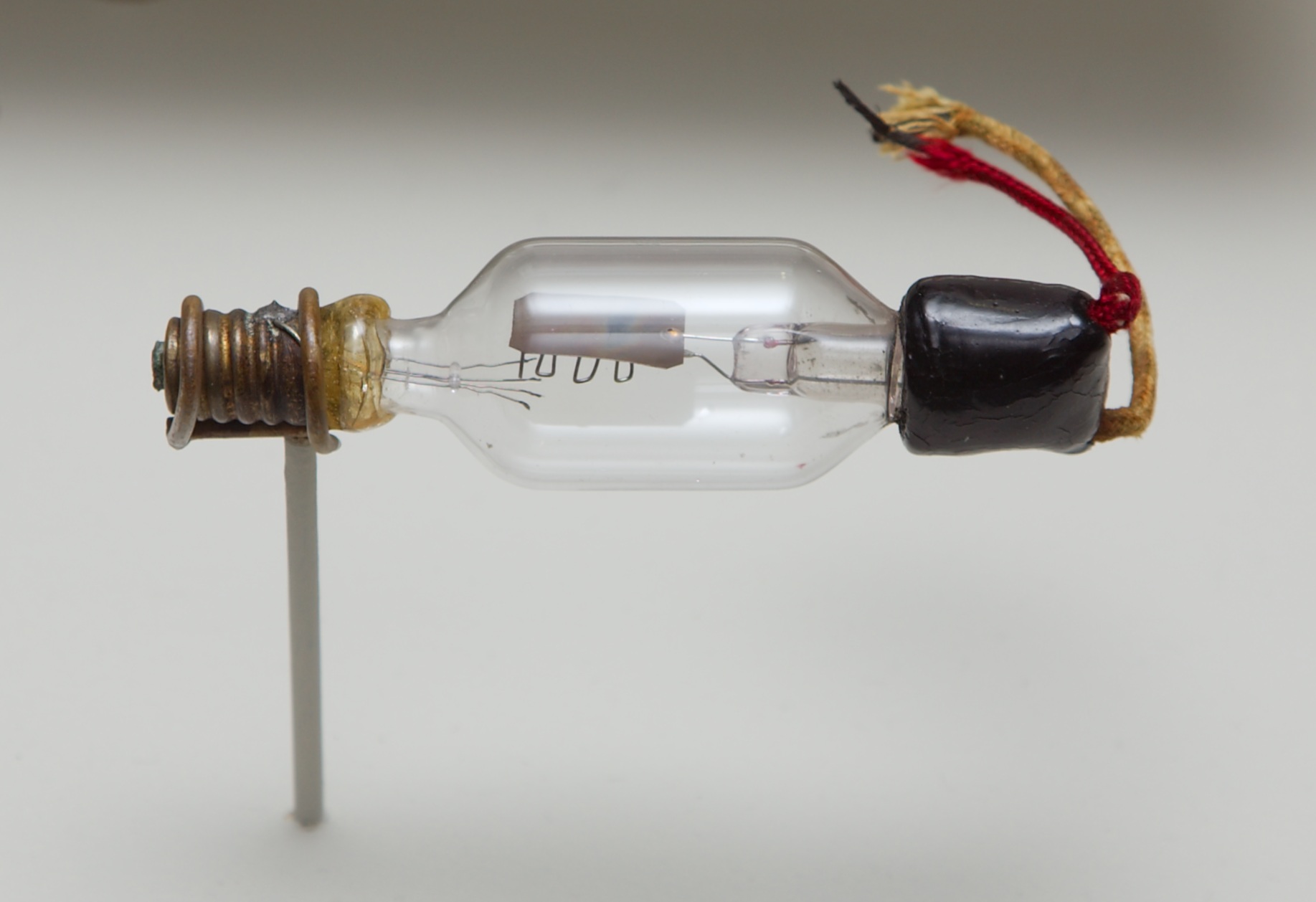He is accredited with the first documented radio broadcast of a live singer, when Eugenia Farrar sang I Love You Truly in an unpublicized test from his laboratory in 1907.
In 1908, on his Paris honeymoon, musical selections were broadcast from the Eiffel Tower as a part of demonstrations of the arc-transmitter - wikipedia ![]()
Lee de Forest (August 26, 1873 – June 30, 1961) was an American inventor, self-described "Father of Radio", and a pioneer in the development of sound-on-film recording used for motion pictures. He had over 180 patents, but also a tumultuous career - he boasted that he made, then lost, four fortunes - wikipedia ![]()

American electrical engineer Lee De Forest, the inventor of the triode vacuum tube, with two of his tubes. De Forest's three electrode tube, which he invented in 1906 and called the "Audion", was the first electrical device which could amplify, and began the field of electronics. The small tube (left) was a low power one watt Audion used in radio receivers. The large tube (right) was a high power 250 watt tube used in radio transmitters, which De Forest called an "oscillion". De Forest began making it in 1919 so that may be the date of this picture.
- wikimedia.org ![]()
He was also involved in several major patent lawsuits, spent a substantial part of his income on legal bills, and was even tried (and acquitted) for mail fraud.

Photograph of a February 24, 1910 radio broadcast, from Lee DeForest's laboratory in New York City, by Mme. Mariette Mazarin of the Manhattan Opera Company. From "A Review of Radio" by Lee DeForest, page 333 of the August, 1922 issue of Radio Broadcast.
- wikimedia.org ![]()
His most famous invention, in 1906, was the three-element "Audion" (triode) vacuum tube, the first practical amplification device.

An early De Forest audion tube, the first electron tube that could amplify. The first triode, or tube with three electrodes, a filament, grid, and plate, the audion was invented in 1906 by American engineer Lee De Forest. The top metal electrode is the plate. The zigzag metal wire partly visible under it is the grid. The filament was originally under that, attached to the wires at left, but has burned out. As many Audions did, this model had two filaments (indicated by the four filament supply wires) so that when one burned out the "spare" could be used. The filament wires were attached to the screw terminal at left, while the grid and plate terminals were brought out through the right end of the glass envelope to the two wires at right. Tube belongs to History of San Jose, Perham Collection of Early Electronics.
- wikimedia.org ![]()
Although De Forest had only a limited understanding of how it worked, it was the foundation of the field of electronics, making possible radio broadcasting, long distance telephone lines, and talking motion pictures, among countless other applications.
Lee DeForest broadcasting Columbia phonograph records, from page 52 of the November 4, 1916 The Music Trade Review
- wikimedia.org ![]()
# Renewed broadcasting activities
In the summer of 1915, the Radio Telephone Company received an Experimental license for station Radio 2XG, located at its Highbridge laboratory.
In late 1916, Lee de Forest renewed the entertainment broadcasts he had suspended in 1910, now using the superior capabilities of vacuum-tube equipment.
Radio 2XG's debut program aired on October 26, 1916, as part of an arrangement with the Columbia Graphophone Company to promote its recordings. Beginning November 1, the "Highbridge Station" offered a nightly schedule featuring the Columbia recordings.
Some time in 1920 De Forest's returned to San Francisco in March, taking 2XG's transmitter with him. A new station, 6XC (KZY), was established as "The California Theater station", which de Forest later stated was the "first radio-telephone station devoted solely" to broadcasting to the public.
# See also * Early life * Early radio work * American De Forest Wireless Telegraph Company * Radio Telephone Company * Employment at Federal Telegraph * Reorganized Radio Telephone Company * Phonofilm sound-on-film process * Later years and death * Legacy * Awards and recognition * Personal life * Quotes * Patents * See also * References * Further reading * External links